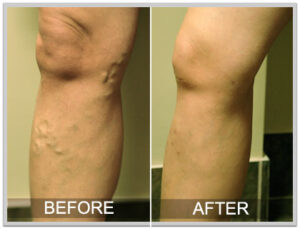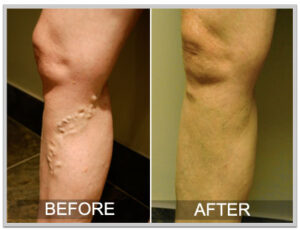VARICOSE VEINS
What are varicose veins?
It is perfectly normal to have visible veins on your legs and arms. Varicose veins are veins under the skin of the legs that have become larger and more tortuous than normal. They are not the same as spider (thread) veins. These are tiny veins in the skin itself. Although unsightly, these do not cause any trouble and treatment for these is not covered by insurance.
What causes varicose veins?
Blood flows down the legs through the arteries and back up the leg through the veins. There are two main
systems of veins in the legs, the deep veins which carry most of the blood back up the legs to the heart and the superficial veins under the skin, which are less important and can form varicose veins. All of these veins contain valves, which should only allow the blood to flow upwards. If the veins become stretched, these valves no longer work properly. Blood can then flow backwards down the veins and this can produce a head of pressure when standing, walking about or sitting. Lying down or putting your feet up relieves the pressure and usually makes the legs feel better. The trouble people get from their varicose veins is very variable.
Who can get varicose veins?
- Usually there is no special cause for varicose veins but they often run in families.
- In women, varicose veins often appear first in pregnancy, when hormones relax the walls of the veins and when the womb presses on the veins coming up from the legs.
- People who are overweight are more likely to get varicose veins and to find symptoms from them troublesome.
- Sometimes varicose veins develop after a deep vein thrombosis (post-thrombotic syndrome) or after a broken leg. Both of these can damage the deep veins leading to higher pressure in the superficial veins
What are the symptoms of varicose veins?
Many people have no symptoms at all, except for the fact that the veins are noticeable, and they may cause embarrassment. Other than cosmetic problems, the commonest symptoms from varicose veins are:
- Aching and itching over the varicose veins, usually worse in hot weather.
- Heaviness and swelling of the lower legs, usually worse at the end of the day.
These symptoms are not necessarily serious but can be treated if they are sufficiently troublesome. Although varicose veins can get worse over the years, this often happens very slowly. It is best to leave them alone until they cause trouble.
Are varicose veins dangerous?
Varicose veins can cause serious problems. This includes ulceration of the skin, chronic leg swelling, cellulitis (soft tissue infection), bleeding and phlebitis (superficial clots). In some people the high venous pressure causes damage to the skin near the ankle which can become brown and eczematous. If these changes progress, or if the skin is injured, an ulcer may result. Varicose veins can become inflamed, hard, painful and tender. This is called superficial thrombophlebitis (or bleeding as a result of traumatizing a varicose vein. Any complication of varicose veins is a good reason to visit your GP to request referral to a specialist.
What treatments are available for varicose veins?
Various treatments are available for varicose veins depending on their location, severity and your fitness for surgery. Your surgeon will discuss the options with you in the outpatient clinic after examining you. A painless duplex ultrasound scan may be required before deciding what treatment is required.
Conservative treatment: This consists of advice to you about lifestyle, exercise, leg elevation and the use of compression hosiery.
Endovenous Laser/Radiofrequency Ablation:Â New techniques have recently been developed which avoid the need for surgery, while offering considerable shorter recovery. This is an office based procedure which takes less than one hour.


varicose_vein_before_after_002
“I feel 100% better. My leg looks fantastic! I’m going to wear my daisy duke shorts in the summer!” Arlene L.
THE VENOUS SYSTEM ANATOMY
The venous system is made up of a network of veins, including:
- Superficial veins – veins located close to the surface of the skin.
- Deep veins – larger veins located deep in the leg.
- Perforator veins – veins that connect the superficial veins to the deep veins.
EXPERIENCING THE VENEFIT PROCEDURE
The Closure procedure is performed on an outpatient basis. Using ultrasound, your physician will position the ClosureFAST catheter into the diseased vein through a small opening in the skin. The tiny catheter powered by radiofrequency (RF) energy delivers heat to the vein wall. As the thermal energy is delivered, the vein wall shrinks and the vein is sealed closed. Once the diseased vein is closed, blood is re-routed to other healthy veins.
Following the procedure, a simple bandage is placed over the insertion site, and additional compression may be provided to aid healing. Your doctor may encourage you to walk, and to refrain from extended standing and strenuous activities over a period of time.
Most patients who undergo the Closure procedure typically resume normal activities within 1-2 days.
Frequently Asked Questions
Q: Is the Closure procedure painful?
A: Patients generally report feeling little, if any, pain during and after the procedure.
Q: How quickly can I resume normal activity?
A: Patients are encouraged to walk immediately following the procedure, and most patients resume normal activities within 1-2 days.
Q: How soon after treatment will my symptoms improve?
A: Most patients report a noticeable improvement in their symptoms with 1-2 weeks following the procedure.
Q: Is there any scarring, bruising, or swelling after the procedure?
A: Most patients report minimal to no scarring, bruising, or swelling following the Closure procedure.
Q: How is the Closure procedure different from endovenous laser?
A: In the only head-to-head trial of its kind, the ClosureFAST catheter showed statistical superiority over 980nm endovenous laser. Patients treated with the ClosureFAST catheter experienced less pain, less bruising, fewer complications and realized quality of life improvement up to four times faster than those treated with endovenous laser ablation.
Q: How is the Closure procedure different from vein stripping?
A: During vein stripping, incisions are made in the groin and calf, and a stripper tool is threaded through the diseased vein, to pull the vein out of the leg. With the Closure procedure, only one small incision is made at the insertion site and the vein is then closed and left in place. This minimally invasive approach virtually eliminates pain and bruising associated with vein stripping surgery.
Q: Is the Closure procedure covered by insurance?
A: The Closure procedure is covered by most health insurances for patients diagnosed with venous reflux.
UNDERSTANDING VENOUS REFLUX DISEASE
Healthy leg veins contain valves that open and close to assist the return of blood back to the heart. Venous reflux disease develops when the valves that keep blood flowing out of the legs and back to the heart become damaged or diseased. As a result, vein valves will not close properly, leading to symptoms of:
- Varicose veins
- Pain
- Swollen Limbs
- Leg heaviness and fatigue
- Skin changes
- Ulcers
ARE YOU A CANDIDATE?
Many factors contribute to the presence of venous reflux disease, including:
- Age
- Gender
- Family history
- Heavy lifting
- Multiple pregnancies
- Standing profession
Using ultrasound to scan your leg(s), your physician will determine if venous reflux is present.
PROCEDURAL HIGHLIGHTS
- Relief of symptoms
- Outpatient procedure
- Can be performed under local anesthesia
- Most patients resume normal activities within 1-2 days
- Good cosmetic outcome with minimal or no scarring, bruising or swelling

